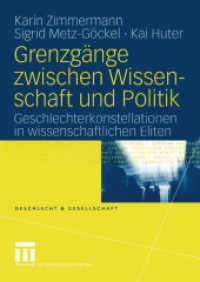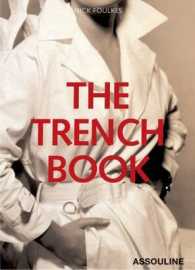- ホーム
- > 洋書
- > 英文書
- > Literary Criticism
Full Description
Newest research into drama and performance from the Middle Ages and the Tudor period.
Medieval English Theatre is the premier journal in early theatre studies. Its name belies its wide range of interest: it publishes articles on theatre and pageantry from across the British Isles up to the opening of the London playhouses and the suppression of the civic religious plays, and also includes contributions on European and Latin drama, together with analyses of modern survivals or equivalents, and of research productions of medieval plays.
This volume offers new perspectives in three important areas. It opens with an investigation of the tantalising image of the Black Tudor trumpeter, John Blanke, in the Westminster Tournament Roll. Complementing the assessment of the documentary evidence for his employment in our last volume, it uncovers the surprising complexity of how Islamic dress was represented at the court of Henry VIII. Two essays engage with the challenging Croxton Play of the Sacrament, discussing very different issues of bodily integrity. The first revealingly brings together medieval and posthumanist theory, proposing how in performance the play can move to obliterate the distinction between Jewish and Christian bodies. The second considers the play in the light of modern disability theory, before examining the often contrasting evidence of lives lived, and performances informed, by actual disabled performers.
The final contributions focus on twentieth- and twenty-first-century performances of medieval material, and how it can be adapted for later times and sensibilities. Investigation of an almost unknown 1924 London performance of a fifteenth-century French nativity play reveals much about early twentieth-century views of medieval drama. Meanwhile, the 2023 coronation of King Charles III prompts an analysis of a spectacular ceremony balanced between asserting its medieval origins and demonstrating its modern relevance. Finally, a review of a story-telling performance assesses how the problematic material of The Seven Sages of Rome might be addressed to modern audiences and preoccupations.
Contents
John Blanke's Hat and its Contexts, Part 1: Turbans and Islamic Dress at the Court of Henry VIII - Meg Twycross
Disjointed Unison: Bodily Porousness and Subversion in the Croxton Play of the Sacrament - Sadegh Attari
The Disabled Body as Performance: 'Disabled' Performers in the Records of Early English Drama - Mark Chambers
From Huy to Primrose Hill: An Early Twentieth-Century English Re-Playing of a Fifteenth-Century Liégeois Nativity Play - Janet Cowen
'More medieval morality play than 21st century': Spectacle and its Meaning at the Coronation of King Charles III - Aurélie Blanc
The Seven Sages of Scotland: The Scottish Storytelling Centre, Edinburgh, Saturday 22 July 2023 - Sarah Carpenter






